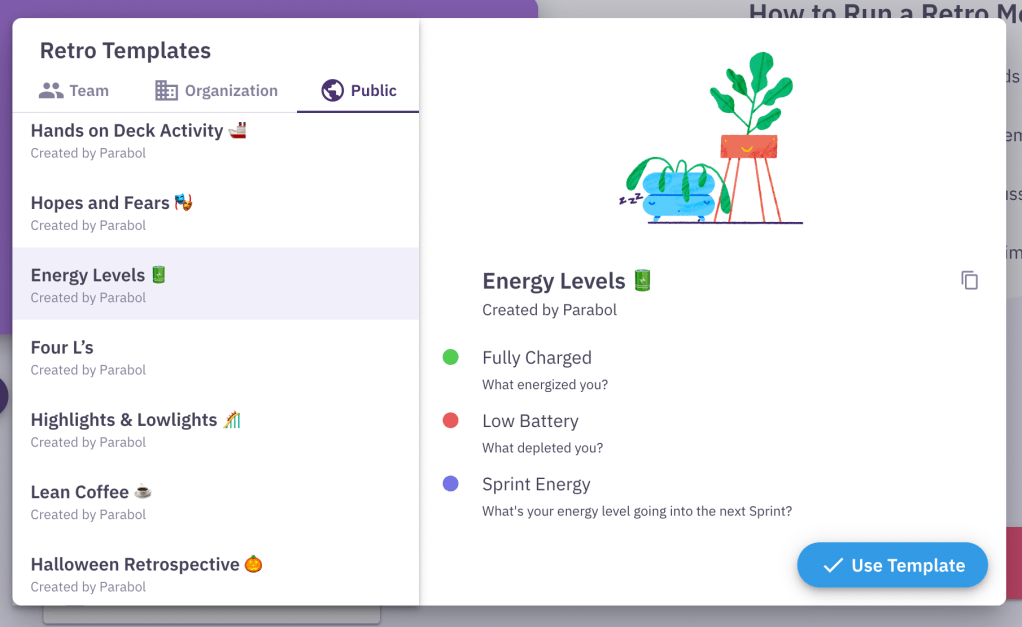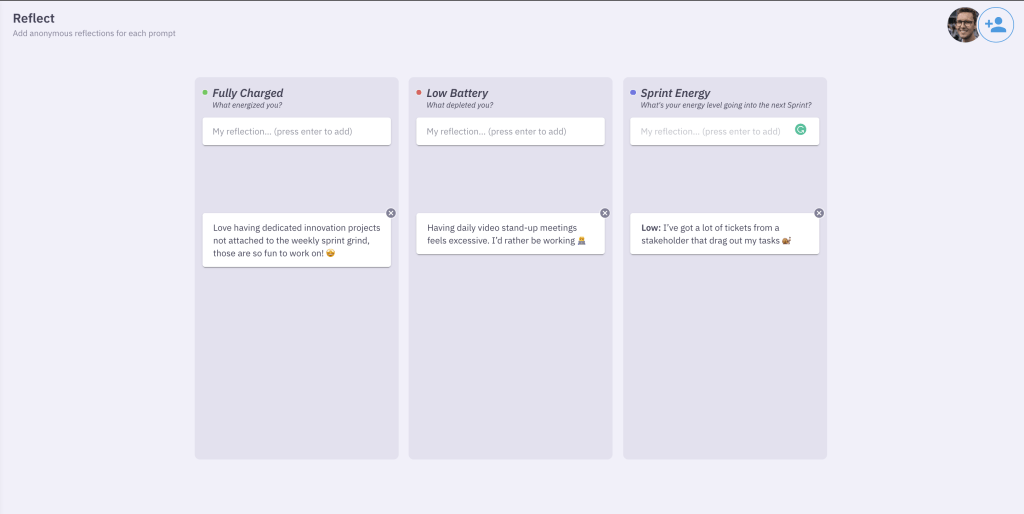Energy Levels Retro
Identify what’s draining your team and what’s powering them up

What is an Energy Levels retrospective?
The Energy Levels retrospective template is a great way to assess how your team is feeling about their work.
Discussing the energy levels of your team as you move between sprints and projects can help you keep everyone motivated and help you identify vampiric activities that drain the team. The Energy Levels retrospective was originally created by Parabol.
Here’s how you can prompt reflections with an Energy Levels retrospective:
What tasks give you energy?
These are the things that charge your team up, stuff that makes them excited or leaves then feeling refreshed. Think of these as the kind of activities that make you forget about the time and give you a sense of flow.
(Example: Love having dedicated innovation projects not attached to the weekly sprint grind, those are so fun to work on!)
What tasks take energy away from you?
These can be the tasks that drain you, that leave you feeling like maybe it’s time to call it a day. It’s important to remember they don’t necessarily have to be bad tasks. Energy is finite, these are tasks that consume a lot of it.
(Example: Having daily video stand-up meetings feels excessive. I’d rather be working)
What is your energy level moving into the next sprint?
This category can be as simple as low, medium or high, though feel free to allow team members to elaborate. If you want to get more precise, ask your team to estimate their power level with a percentage. When energy levels are low, as whether it’s because of the last sprint, or because the next one looks daunting?
(Example: Low, I’ve got a lot of tickets from a stakeholder that drag out my tasks)
Benefits of running an Energy Levels retrospective
An Energy Levels retro can help you find activities that are draining the limited supply of energy your team have to do great work.
Look for energy-draining tasks or processes that repeat between sprints. Something that consumes a lot of energy, but is relatively rare, might not be as much of a concern as a routine task that seems to be taking a toll on the team.
You can also look for the inverse, what are the routine things that regularly recharge your team? Can you incorporate more of those? This retro could help you strike a better balance.
But be aware that you might run into contradictions: what builds energy for some might sap energy from others. In that case, you can begin a discussion about trading tasks, so everyone can do work that energizes them.
When should you do an Energy Levels retro?
Running an Energy Levels retrospective is a great way to spot trends in how your team feels about work. They can help you identify processes, tasks and even stakeholders that can leave your team in a rut. A low energy team can develop low morale, low productivity, and low job satisfaction.
During the long days of summer
This is a good template if your workflow has any seasonality to it. Maybe things drag in the summer and get overwhelmingly busy in the fall. You can use this retro to identify high energy activities from slower times that you could bring into busier times.
Regularly to spot early signs of burnout
The Energy Levels retrospective is a good way of having an open conversation about burnout. You can use the retrospective to see if your team really feel they are working as a sustainable pace.
This retrospective is like the canary in the coal mine. You can use it to spot early warning signs of burnout. Then take action items to make things better before things get any worse.
To avoid ruts
You don’t have to wait until it feels like your team is in a rut to do an Energy Levels retro. These could be done quarterly or twice a year just to double-check processes and make sure energy levels aren’t falling out of balance.
After long projects
You could also do them after large projects that repeat. For example, maybe you work at an online publication that produces a large financial report twice a year. You can do this retro before and after the report to know what parts of that process consume the most energy. Then maybe you can tweak tasks and processes before the next report to see if you can increase energy levels, morale and job satisfaction.
It’s not always going to be an option to just eliminate tasks that drain the team, but you might be able to spread them out, assign them to two people, or tackle them in chunks.
How to run an Energy Levels retrospective with Parabol
Select Retro Meeting with the arrows, then use the dropdown to select the Energy Levels retro template.

The icebreaker box is checked on by default. You don’t have to do one, but we recommend it. They offer a chance to break the ice and get everyone in a chatty mood that encourages active participation.
When you’ve made your choices, hit that Add Meeting to kick things off!

If you’re doing an icebreaker, you’ll have a random question to answer. You can refresh it if you want another option, or create your own. Maybe something about your favorite energy drink?
After the icebreaker you’ll move on to the reflect stage. This is where you get into the principles of the Energy Levels retro discussed above.
Remember, Parabol is remote-friendly, enabling you to work asynchronously with your team. They can all leave comments together, or do it at a time that works for them. Also, reflections are anonymous, and no one can see them until you’re done working on them.
After the reflect phase, you’ll vote on issues to discuss, talk about the most voted on items, and then get a summary of the retro when you’re done. Make sure to review the retro 101 guide for tips on running a retrospective smoothly.
